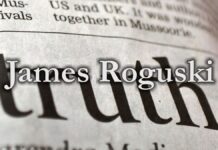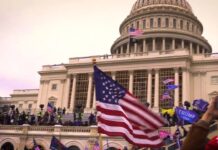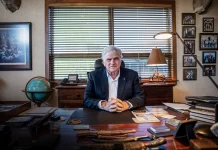Secretary of Defense Mark Esper and Gen. Mark Milley, chairman of the Joint Chiefs of Staff, deliver remarks in the Pentagon Briefing Room on the raid killing Abu Bakr al-Baghdadi, the ISIS leader.
Below is the transcript of the briefing:
SECRETARY OF DEFENSE MARK T. ESPER: Well, good afternoon, everyone.
As President Trump announced yesterday, the United States’ joint Special Operations Forces conducted a successful raid on Saturday night, resulting in the death of Abu Bakr al-Baghdadi, the founder and leader of ISIS. This operation was the culmination of a multi-year interagency effort to find him, and then capture or kill him.
Baghdadi and the thugs who follow him were responsible for some of the most brutal atrocities of our time. His death marks a devastating blow for the remnants of ISIS, who are now deprived of their inspirational leader, following the destruction of their physical caliphate, earlier this year.
I want to thank our brave service members who took part in this daring raid, along with our interagency partners who supported the mission.
There is no guarantee of success in an operation with this level of difficulty. And President Trump knew this when he made the bold decision to order the raid, confident in the expertise of our forces.
Our service members conducted themselves with incredible skill and professionalism, and they executed the raid, in all of its facets, brilliantly. Not a single United States service member was killed in this high-risk operation.
Despite Baghdadi’s death, the security situation in Syria remains complex. Multiple state and non-state actors continue to vie for control of territory and resources within the country.
As we have learned from our recent history in the Middle East, it is very easy to get drawn into continued conflict if our objectives are not clear. Acting as a police force out to solve every dispute is not our mission. Our mission in Syria today remains the same as it was when we first began operations in 2014: to enable the enduring defeat of ISIS.
Our recent repositioning of forces within the country is intended to posture us to continue this mission and give the president options, while returning the balance back home to the United States. Those who remain will continue to execute counterterrorism operations, while staying in close contact with the Syrian Democratic Forces who have fought alongside us.
Additionally, the United States will retain control of oil fields in northeast Syria. At the height of Baghdadi’s reign, these oil fields provided ISIS with the bulk of financial resources used to fund its terror. U.S. troops will remain positioned in this strategic area to deny ISIS access to those vital resources, and we will respond with overwhelming military force against any group that threatens the safety of our forces there.
These oil fields also provide a critical source of funding for the SDF, which enables their ability to secure ISIS’ prison camps and conduct operations against ISIS, among other things.
Last week, I was in Brussels for the NATO defense ministerial, and I spoke with our allies about the situation in Syria. I reiterated our commitment to the defeat of ISIS, and called on other nations, who have much at stake, to offer their support to help mitigate the ongoing security crisis.
Turkey continues to bear responsibility for the consequences of their unwarranted incursion, which has brought further instability to the region. A number of allies have expressed their desire to help with the implementation of a safe zone along the Syria-Turkey border. The United States remains focused on our core mission and continues to work closely with the defeat ISIS coalition as we implement the next phase of the campaign.
Baghdadi’s death will not rid the world of terrorism, or end the ongoing conflict in Syria, but it will certainly send a message to those who would question America’s resolve, and provide a warning to terrorists who think they can hide.
The United States, more than any other nation in the world, possesses the power and the will to hunt to the ends of the Earth those who wish to bring harm upon the American people. Saturday’s operation is just one example of the incredible determination and great skill of the United States military.
I’ll now ask Gen. Milley to provide you with some additional details on the operation. Thank you.
GENERAL MARK MILLEY: So good afternoon everyone. As Secretary Esper stated, the United States Special Operations Forces, under the command and control of United States Central Command Gen. Frank McKenzie, conducted a counter-terrorism operation, which resulted in the death of the founder and the leader of ISIS, Abu Bakr al-Baghdadi.
Intelligence from numerous organizations throughout the Department of Defense, and across the entire interagency, identified the target location approximately four miles from the Turkish border in Idlib Province of Syria.
In order to reduce the risk to U.S. forces and prevent miscalculation and escalation, an action consistent with operations in the past, we coordinated with appropriate militaries and other organizations in the region through established de-confliction mechanisms.
During the mission, U.S. forces were infiltrated by helicopter, and once on the objective, secured the target compound. The assault force was engaged in small arms fire and the threats were quickly eliminated. Our forces isolated the compound and protected all of the non-combatants.
While clearing the objective, U.S. forces discovered al-Baghdadi hiding in a tunnel. The assault force closed in on Baghdadi and ended when he detonated a suicide vest. Baghdadi’s remains were then transported to a secure facility to confirm his identity with forensic DNA testing, and the disposal of his remains has been done, and is complete and was handled appropriately.
The success of this complex operation is an incredible testament to the professionalism of the men and women of the joint force and our interagency partners in their courage and their bravery. They put themselves in harm’s way time and time again to protect our great country.
The secretary and I will now take your questions.
Q: Thank you. Mr. Secretary, you mentioned the — the oil fields and securing the oil fields in the east of Syria. Has the deployment or reinforcements that you announced last week begun, and could you describe more fully what that — what you intend to do there?
SEC. ESPER: We have begun deploying and repositioning additional assets into the vicinity of Deir ez-Zor. As I said the other day, it includes mechanized forces and other types of forces. That will continue until we believe we have sufficient capability to ensure ISIS and other destabilizing actors are denied access to that oil facility.
Q: And just a quick follow up, have you had any indications of any challenges to your presence there or —
SEC. ESPER: Not at this time.
Q: Sir, do you have video of Baghdadi’s final moments? And also, are you partnering with the Kurds again on the ground? Can you explain how difficult this operation would have been if you didn’t have troops or bases on the ground in Syria and in Iraq?
(CROSSTALK)
GEN. MILLEY: Well we do have video and photos. We’re not prepared at this time to release those. They’re going through a declassification process. I think what you’ll see here in the coming days is we’ll set up some operational and tactical level briefings by Central Command, and you’ll be provided some video and — and photos, et cetera, of that.
(CROSSTALK)
Q: How difficult would it have been to carry out this operation if you didn’t have troops on the ground — or bases?
GEN. MILLEY: From an operational standpoint, the United States military can strike any target, anywhere, anytime.
SEC. ESPER: Yeah, I was going to say the same thing. We have incredible reach. We — we can strike anybody, anytime, anywhere. The terrorists should be aware of that; they should have seen that now after us doing this multiple times.
And with regard to your question regarding the — the SDF, we stay in continuous contact with them.
Q: I wanted to clarify a couple points. First, what was used to destroy the compound? What kind of ordinance was used to destroy the compound? Also, you mentioned that you had video. Do you have video from inside the tunnel itself, and if so, were you able to get that because the K-9 was wearing video, or did you have something else?
GEN. MILLEY: Yeah —
(CROSSTALK)
SEC. ESPER: You just get one.
Q: Okay, how about one and a half? The name of the K-9, please, and —
(Laughter.)
(CROSSTALK)
SEC. ESPER: Three – that’s three.
GEN. MILLEY: So ordinance used — there was multiple types of ordinance used to include the JASSMs [Joint Air to Surface Standoff Missile], the GBUs [Guided Bomb Units], Hellfires, as well as many guns — you know, small arms fire, et cetera. So we used a variety of munitions and those — the bombs were used at the tail end in order to destroy the compound you saw on various videos, et cetera.
Your second question about the video, I’m not going to classify the video, what we do have and don’t have at this time. I’ve seen a lot and I’ll wait until everything’s appropriately declassified here in the coming days, and — and we’ll make sure that you are provided that.
We’re not releasing the name of the dog right now. The dog is still in theater. The dog, the K-9, the military working dog performed a — a tremendous service, as they all do, in — in a variety of situations. Slightly wounded and fully recovering, but the dog is still in theater, returned to duty with its handler.
So we’re not going to release just yet photos or names of dogs or anything else.
SEC. ESPER: Protecting his identity.
GEN. MILLEY: Protecting the dog’s identity.
Q: Are you willing to say that — whether Baghdadi was buried at sea?
SEC. ESPER: That’s four questions now.
Q: A follow-up — a follow-up.
GEN. MILLEY: Baghdadi was — is — his remains were disposed of appropriately in accordance with our SOPs, and in accordance with the law of armed conflict.
STAFF: Next question.
Q: Was this Baghdadi’s headquarters, his compound, or was he just passing through? And if it was his headquarters, how much material did you take away?
GEN. MILLEY: There was material taken away. I — I don’t want to characterize exactly what or how much yet until it gets exploited properly, but as a matter of course, we always do sensitive site exploitation on any objective anywhere to do that.
As to whether it was his headquarters, it was an area in which he was staying on a consistent basis.
Q: And what about prisoners? You took some. How many? In whose custody are they in now?
GEN. MILLEY: They’re in our custody, and they’re at a secure facility.
STAFF: Next question, Dan Lamothe.
Q: Can you tell us how many?
GEN. MILLEY: There were two adult males taken off the objective alive. They’re in our custody.
Q: Gentlemen, thank you for your time today.
I wanted to look at the what’s next aspect. The president alluded to materials being collected from — from the site itself, can you, in any way, elaborate on — on what’s been collected, what’s being looked through now and what that might mean?
GEN. MILLEY: It would be best not to for operational reasons, because that information needs to be exploited properly for any follow-on missions that we may choose to do.
SEC. ESPER: And I think the — the what next is, it — we will continue the mission and the mission is to ensure the enduring defeat of ISIS in the region, and that’s our mission.
Q: A follow up, please? We’ve seen reporting that this raid was launched from Al Asad, from Erbil. Can you clarify on where it came from?
GEN. MILLEY: Operationally — we’re not going to discuss the location from which the raid took place. It took place obviously in — in — somewhere in the region.
STAFF: Barbara Starr.
Q: Gen. Milley, can I take you back to the question on the oil fields and the military role in the oil fields mission, if I may? So you’re going to protect them again, and keep control against ISIS and other potential — potential adversaries. Do — do your — does it include the possibility, in your view, that U.S. troops are prepared to deny access to the oil fields to either Russian and/or Syrian forces? Is that, in fact, part of your mission, to specifically deny them access?
And my follow on to that is, how do you know when you — what do you need to see to know you’re done with the oil fields mission? Presumably you’re not keeping troops there absolutely forever. How do you know when you’re done? What do you need to see, from Russia and Syria, please?
GEN. MILLEY: Yes, so the question you’re asking, Barbara, is about purpose and end state on — and then the ways would be the military question. So I’m going to punt over to the secretary specifically for that.
But your — the military task that we’ve been given is to secure, continue to secure, At Tanf, which is down along the — you know where that is, down along the tri-border area. We’ll continue to do that, and to secure the Conoco oil fields in and around Deir ez-Zor. That is in the vicinity of the Middle Euphrates River Valley that you’re familiar with, and the fundamental purpose of securing those oil fields is to deny those oil fields access to ISIS in order to prevent ISIS from resurgence, because we are still committed to the counter-ISIS campaign, and we don’t want them to resurge. They get a lot of their revenues from that.
But I’ll let the secretary talk about end states.
Q: My specific question is within — what do you want to do in the oil fields, does that include denying access, preventing Russian or Syrian forces, which now have changed the battle-space?
SEC. ESPER: So the short answer is yes, it presently does, because in that case we want to make sure that SDF does have access to the resources in order to guard the prisons, in order to arm their own troops, in order to assist us with the Defeat-ISIS mission. So that’s our mission, is to secure the oil fields.
(CROSSTALK)
Q: You just said you would deny Russia and the regime —
STAFF: Next question —
(CROSSTALK)
Q: Gen. Milley, President Trump described yesterday Baghdadi whimpering and crying before he died. Can you elaborate or confirm those details?
GEN. MILLEY: I — secretary was asked the same question yesterday. I know the president had planned to talk to unit and unit members, but I — I don’t know what the source of that was. But I assume it was talking directly to unit and unit members.
Q: So you don’t have — you haven’t talked to any unit members that described that to you?
GEN. MILLEY: I have not talked to unit members, no, that’s correct. I’ve talked to the commander of CENTCOM and others, but not down to the unit members down at that level of fidelity.
STAFF: All right, last question, Carla Babb.
Q: Thank you for doing this.
The SDF commander has said that there was an SDF member that was part of this raid. He’s talked about the intelligence that the SDF provided, putting a person inside with ISIS. Can you confirm all of those details on your end? And then also on the oil fields, can you just talk about the overall picture in Syria now after these last couple of weeks, putting more people into protecting oil fields. Are there going to be more troops now in Syria than there were before, or less?
SEC. ESPER: I’ll take the second question first and I’ll let the chairman ask — answer the first one. Look, we’re — we’re — as I said, we’re reinforcing our position in — at Deir ez-Zor, that area. We also were given the earlier directive to retain forces at the At Tanf garrison.
At the end of the day, we’re — we will be sending troops home. That’s — the president made a commitment to do that. But in the meantime, we’re going to reinforce and make some other moves to ensure that we can accomplish that mission of securing the oil fields in order to deny them access to ISIS.
Q: But will there be more going in than there were coming out? Sorry, just to clarify.
SEC. ESPER: No, no, no. At the end of the day, my expectation is that it’ll be fewer than what we had before and they will be going home.
GEN. MILLEY: And help me out, remind me of the first question.
Q: The first question was about the SDF commander saying that —
GEN. MILLEY: Yeah, yeah. So this was a U.S.-only operation for personnel that were on the objective. I know what you’re referring to. There was a comment somewhere, reported in the media, that the SDF had soldiers, or troops, or one person, or something on the objective with our forces.
I’m not going to comment on what may or may not have happened with the SDF on the objective. The actions on the objective, the aircraft coming in, the aircraft overhead and the soldiers conducting the assault, was a U.S.-only operation.
STAFF: All right. Thanks, guys. If you have any follow-ups, you can to me or Mr. Hoffman.











































